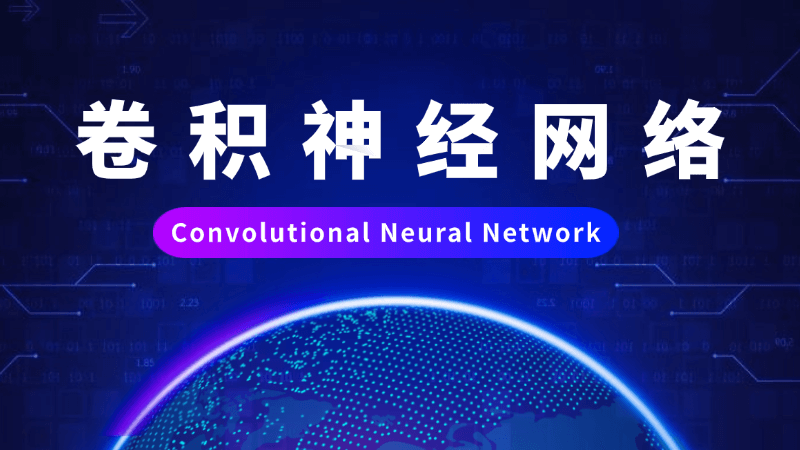What is Convolutional Neural Network (CNN), in one article
Definition of convolutional neural network
Convolutional Neural Network (CNN), an artificial neural network specifically designed to process data with a lattice structure, has excelled in the field of image and video analysis. The term "convolution" is derived from the mathematical operation of convolution, which refers to the process of localized feature extraction from input data by means of a sliding window. Unlike traditional neural networks, convolutional neural networks draw on the principles of the biological visual system, simulating the way the human cerebral cortex processes visual information, and gradually abstracting the hierarchical features of the data through a hierarchical structure. A convolutional neural network acts like an intelligent filter that automatically learns from raw data and recognizes meaningful patterns, such as edges, textures, or objects in an image. This network structure was proposed in the 1980s and was not widely used until recent years with the increase in computing power and the emergence of big data. From cell phone face recognition in daily life to medical image analysis, convolutional neural networks have become an important part of modern artificial intelligence technology, driving the rapid development of the field of computer vision.

Historical Development of Convolutional Neural Networks
The development of convolutional neural networks has been full of innovations and breakthroughs, and their evolution reflects the cross-fertilization of computer science and neuroscience.
- Early budding stage:The concept of convolutional neural networks dates back to the 1950s and 1960s, when neuroscientists David Huber and Thorstein Wiesel discovered that neurons respond to edges in specific directions by studying the visual cortex of cats, which inspired the idea of localized receptive fields in artificial neural networks. But it wasn't until 1980 that Japanese scholar Kunihiko Fukushima proposed the Neocognitron model, a prototype of convolutional neural networks, which introduced a hierarchical structure and local connectivity for handwritten character recognition.
- Key Theory Foundations:In the 1990s, researchers such as Le-Cun Yan first combined the backpropagation algorithm with a convolutional structure to develop the LeNet-5 model for digit recognition, which was successfully applied to a bank check processing system. This stage laid the basic framework of convolutional neural networks, including the combination of convolutional, pooling and fully connected layers.
- The revival of deep learning:At the beginning of the 21st century, the development of convolutional neural networks stagnated for a while due to computational resource limitations and data scarcity. However, after 2006, Jeffrey Hinton and others pushed for a deep learning renaissance, and AlexNet made a breakthrough in the ImageNet competition in 2012, utilizing graphics processor acceleration and random discarding techniques to dramatically reduce the error rate of image recognition, igniting a research boom in convolutional neural networks.
- Modern Evolution and Innovation:Subsequently, deeper network architectures such as VGG, GoogLeNet, and ResNet were proposed to solve the gradient vanishing problem and improve performance through techniques such as residual connectivity. These advances have enabled convolutional neural networks to reach the human level in tasks such as target detection and semantic segmentation.
- Current Trends and Implications:In recent years, convolutional neural networks have been combined with reinforcement learning and generative adversarial networks to expand into areas such as video analytics and autonomous driving. Historical development shows that the evolution of convolutional neural networks is not only the accumulation of technology, but also the result of multidisciplinary collaboration, which will continue to push the boundaries of artificial intelligence in the future.
Core structure of convolutional neural networks
The core structure of a convolutional neural network consists of multiple hierarchical components, with each layer assuming a specific function and working together to achieve feature extraction and classification.
- Convolutional Layer:As the basis of the network, the convolutional layer computes feature mappings of localized regions by sliding convolutional kernels (filters) over the input data. Each convolutional kernel focuses on detecting specific patterns, such as edges or corners, and a parameter sharing mechanism ensures efficient learning and reduces the risk of overfitting.
- Pooling layer:Typically following the convolutional layer, a pooling layer (e.g., maximum pooling or average pooling) downsamples the feature mapping, retaining important information while reducing the spatial dimensionality. Enhances the translational invariance of the model and reduces the computational burden, making the network more robust to input changes.
- Activation function:Nonlinear transformations are introduced to enable the network to learn complex patterns. Commonly used functions include linear rectification units, which are simple and efficient, alleviate the problem of vanishing gradients, and facilitate the convergence of the training process.
- Full connectivity layer:Located at the end of the network, the fully connected layer integrates the previously extracted features and outputs the final classification or regression results. This layer is similar to a traditional neural network and is responsible for advanced semantic reasoning, but may have a large number of parameters and needs to be combined with regularization techniques to avoid overfitting.
- Output Layer:Designed according to the type of task, e.g., using a flexible maximum function for multiclassification that outputs a probability distribution. The entire structure is trained end-to-end to optimize parameters to minimize the loss function for automated feature engineering.
How Convolutional Neural Networks Work
Convolutional neural networks work on the basis of a hierarchical feature learning and forward propagation mechanism that mimics the progressive abstraction process of the human visual system.
- Input Processing:The network receives raw data such as image pixel matrix and performs preprocessing such as normalization to normalize the input range and improve training stability. The input data is considered as a multidimensional tensor to facilitate convolutional operations.
- Feature extraction phase:By alternating multiple convolutional and pooling layers, the network progressively extracts low-level to high-level features. Initial layers capture simple elements such as lines and colors, deeper layers of the network recognize complex objects such as faces or vehicles, and a hierarchical structure allows combining simple features to form high-level representations.
- Parameter optimization:In forward propagation, the data is passed layer by layer and the output values are calculated; then the gradient is calculated based on the loss function (e.g., cross entropy) through a back-propagation algorithm and the weights are updated using an optimizer, such as stochastic gradient descent, to minimize the prediction error.
- Regularization and generalization:To avoid memorizing training data, techniques such as randomly discarding some neurons or batch normalization accelerate training. These measures enhance the generalization ability of the model so that it performs well on unseen data.
- Reasoning and Output:Once training is complete, the network can be used for inference tasks, where inputting new data directly outputs predictions. The whole process emphasizes localization and hierarchy, making the convolutional neural network efficient and adaptable.
Application of Convolutional Neural Networks in Image Recognition
Convolutional neural networks have a wide range of applications in image recognition and have virtually reshaped the landscape of modern computer vision.
- Object detection and classification:In the automatic driving system, the convolutional neural network identifies pedestrians, vehicles and traffic signs on the road in real time, and realizes high-precision localization and classification to improve safety performance through models such as the you-look-once algorithm or regional convolutional neural networks.
- Facial recognition technology:Social media and security systems utilize convolutional neural networks for face verification and sentiment analysis, such as Facebook's photo tagging feature, or cell phone unlocking systems, relying on feature point extraction and matching to achieve high accuracy rates.
- Medical Image Analysis:In the medical field, convolutional neural networks assist doctors in diagnosing diseases, such as detecting tumors from X-rays, or segmenting brain regions in MRI scans, increasing early detection rates and reducing human error.
- Art and Creative Applications:Convolutional neural networks drive style migration algorithms, applying the style of famous paintings to ordinary photographs, or generating works of art, expanding the boundaries of the creative industry and making AI a tool for artistic creation.
- Industrial quality control:Convolutional neural networks are used in the manufacturing industry to detect product defects, such as defective electronic components or textile stains, to improve productivity and reduce costs through automated inspection.
Advantages of Convolutional Neural Networks
Convolutional neural networks exhibit multiple advantages in processing image data, and these features make them the preferred choice for computer vision tasks.
- Parameter efficiency:Through local connectivity and parameter sharing, convolutional neural networks drastically reduce the number of parameters, are easier to train and require less computational resources than fully connected networks, and are suitable for deployment in mobile devices or embedded systems.
- Translation invariance:Pooling operations and convolutional structures make the network robust to translations, rotations, and scaling of the input data, capable of recognizing objects regardless of their position, mimicking the adaptability of human vision.
- Automatic feature learning:While traditional methods require manual design of feature extractors, convolutional neural networks automatically learn relevant features from data, reducing manual intervention and improving model accuracy and generalization.
- Hierarchical representation:The multilayer structure allows the network to build a hierarchy of features from simple to complex, with the deeper network capturing the abstract semantics and the shallower network handling the details, a division of labor that enhances interpretability and performance.
- Scalable:Convolutional neural networks are easy to combine with other architectures, such as recurrent neural networks for processing video sequences or generative adversarial networks for image synthesis, to advance multimodal AI.
Limitations of Convolutional Neural Networks
Despite their power, convolutional neural networks have some limitations that affect their application and effectiveness.
- Computing resource requirements:Deep network training requires a large amount of graphics processor memory and time, which is difficult to deploy for resource-limited environments, and inference may be slow, affecting real-time applications.
- Overfitting risk:When the training data is insufficient or of poor quality, the network is prone to overfitting, remembering noise rather than learning generalized patterns, and needs to rely on data augmentation or regularization techniques for mitigation.
- Poor Interpretation:The decision-making process of convolutional neural networks often resembles a black box, making it difficult to understand why a particular prediction was made, which raises trust issues in high-stakes areas such as healthcare or law.
- Sensitive to input size:Networks typically require fixed-size inputs, and preprocessing such as cropping or scaling may lose information, limiting the ability to process variable-size data.
- Weak domain adaptation:Performance degradation is evident when the training data distribution differs significantly from the real world, e.g., models trained from natural images do not perform well on medical images and require additional migration learning adjustments.
Training methods for convolutional neural networks
Training a convolutional neural network is an iterative optimization process that involves multiple steps and techniques to ensure effective learning.
- Data preparation:Collect and label large-scale datasets and perform preprocessing such as enhancement (rotation, flipping) to increase data diversity and improve model robustness.
- Loss function selection:Define the loss function according to the task, cross entropy loss is commonly used for classification tasks, mean square error is used for regression tasks, and the loss function measures the gap between the predicted and true values and guides the direction of optimization.
- Optimization algorithms:Stochastic gradient descent or its variants such as adaptive moment estimation is used to update the network weights by calculating the gradient, and learning rate scheduling such as cosine annealing helps to converge to the global optimum.
- Regularization techniques:Use randomly discarded neurons, or weight decay to penalize large weights and prevent overfitting; batch normalization stabilizes the training process and accelerates convergence.
- Validation and Tuning:Split the data into training, validation, and test sets, monitor validation set performance to adjust hyperparameters such as the number of layers or filters, stop early to avoid overfitting, and ensure model generalization.
Future Directions for Convolutional Neural Networks
Future trends in convolutional neural networks focus on innovative architectures and cross-domain integration to address emerging challenges.
- Lightweight design:Developing more efficient models such as mobile networks or mashup networks that reduce the number of participants and computational costs for edge computing and IoT devices to drive AI adoption.
- Interpretability and Transparency:Research on attention mechanisms or visualization tools to enhance the interpretability of network decisions, meet ethical needs, and build user trust in critical applications.
- Multimodal fusion:Combining natural language processing or sensor data to build multimodal networks to handle joint video, audio, and text tasks, such as environment sensing in autonomous driving.
- Self-supervised learning:Utilizing unlabeled data for pre-training through pre-tasks reduces the dependence on labeled data, reduces cost, and extends the range of applications.
- Bioinspired Innovation:Drawing on new discoveries in neuroscience, we are designing network structures that are more biologically compatible, such as pulsed neural networks, to improve energy efficiency and performance, and to open up a new era of artificial intelligence.
Practical examples of convolutional neural networks
Examples of convolutional neural networks in real-world scenarios demonstrate their transformative impact across multiple industries.
- Self-driving cars:Tesla's Autopilot uses a convolutional neural network to process camera data in real time, identifying lanes, obstacles, and traffic lights to enable partially autonomous driving and improve road safety.
- Medical Diagnostic Assistant:Google Health develops convolutional neural network model to detect diabetic retinopathy from retinal scans, aiding physicians in providing early diagnosis and improving patient outcomes.
- Agricultural Intelligence:Farms apply convolutional neural networks to analyze crop images taken by drones to monitor pests and diseases or irrigation needs to optimize farm management and increase yields.
- Retail and e-commerce:Amazon utilizes convolutional neural networks for product recommendation and visual search, where users can upload images to find similar products and enhance the shopping experience.
- Entertainment & Games:Video games such as NVIDIA's Deep Learning Supersampling technology use convolutional neural networks to enhance the quality of image rendering, enabling real-time super-resolution for a more immersive experience.
Ethical Considerations for Convolutional Neural Networks
The wide application of convolutional neural networks raises ethical issues that need to be addressed and solved by society.
- Risk of privacy violations:Facial recognition technology may be misused for surveillance and invasion of personal privacy, and regulations are needed to limit its use and protect the rights of citizens.
- Bias and Fairness:Bias in the training data leads models to discriminate against specific groups, such as race or gender, and should be mitigated through fair algorithm design and diverse data collection.
- Employment impact:Automation replaces some manual jobs, such as manufacturing quality inspectors, and retraining programs need to be promoted to help transition the workforce.
- Safety and Reliability:In critical systems such as healthcare or transportation, where model errors can lead to serious consequences, rigorous testing and redundant designs must be in place to ensure safety.
- Environmental costs:Training large models consumes large amounts of energy and exacerbates carbon footprints, and researching green AI techniques to optimize energy efficiency for sustainable development.
Educational Resources for Convolutional Neural Networks
There are multiple ways to learn about convolutional neural networks, with a wealth of resources for learners at all levels.
- Online courses:Large open online course platforms offer deep learning-specific courses taught by experts such as Andrew Ng, covering convolutional neural network fundamentals and practice.
- Books and Textbooks:The Deep Learning textbook provides theoretical depth combined with code examples for systematic learning.
- Open Source Framework:The open source machine learning framework provides pre-built models and tutorials for beginners to get up to speed quickly with hands-on projects.
- Community & Forums:Machine learning communities on code hosting platforms or social news sites share code and experiences to promote collaborative learning.
- Academic Research:Read top conference papers such as the Computer Vision and Pattern Recognition Conference to learn about the latest advances and stimulate innovative thinking.
© Copyright notes
Article copyright AI Sharing Circle All, please do not reproduce without permission.
Related articles

No comments...




